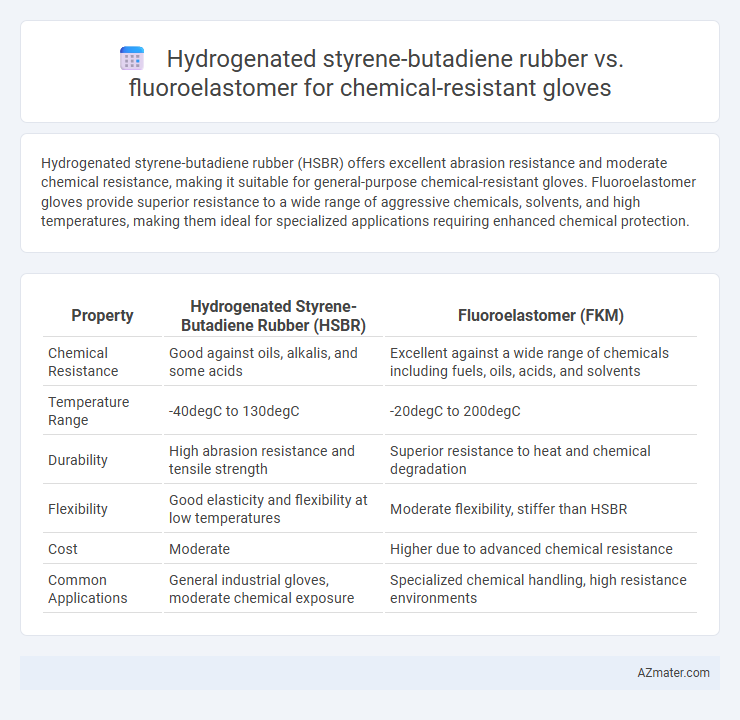Hydrogenated styrene-butadiene rubber (HSBR) offers excellent abrasion resistance and moderate chemical resistance, making it suitable for general-purpose chemical-resistant gloves. Fluoroelastomer gloves provide superior resistance to a wide range of aggressive chemicals, solvents, and high temperatures, making them ideal for specialized applications requiring enhanced chemical protection.
Table of Comparison
| Property | Hydrogenated Styrene-Butadiene Rubber (HSBR) | Fluoroelastomer (FKM) |
|---|---|---|
| Chemical Resistance | Good against oils, alkalis, and some acids | Excellent against a wide range of chemicals including fuels, oils, acids, and solvents |
| Temperature Range | -40degC to 130degC | -20degC to 200degC |
| Durability | High abrasion resistance and tensile strength | Superior resistance to heat and chemical degradation |
| Flexibility | Good elasticity and flexibility at low temperatures | Moderate flexibility, stiffer than HSBR |
| Cost | Moderate | Higher due to advanced chemical resistance |
| Common Applications | General industrial gloves, moderate chemical exposure | Specialized chemical handling, high resistance environments |
Introduction to Chemical Resistant Gloves
Chemical resistant gloves are essential for protecting hands from hazardous substances, with Hydrogenated styrene-butadiene rubber (HSBR) and Fluoroelastomer being two prominent materials used in their manufacture. HSBR offers excellent resistance to aqueous chemicals and wear, while Fluoroelastomer provides superior protection against a wide range of oils, fuels, and aggressive solvents. Selecting the appropriate material depends on the specific chemical exposure and durability requirements in industrial or laboratory environments.
Key Properties of Hydrogenated Styrene-Butadiene Rubber (HSBR)
Hydrogenated styrene-butadiene rubber (HSBR) offers exceptional chemical resistance, particularly against oils, fuels, and certain hydrocarbons, making it an ideal material for protective gloves in harsh chemical environments. Its enhanced saturation through hydrogenation improves thermal stability and aging resistance, ensuring durability under prolonged exposure to heat and oxidizing agents. HSBR also provides excellent abrasion resistance and flexibility, enhancing comfort and dexterity for users requiring reliable chemical protection.
Key Properties of Fluoroelastomer (FKM)
Fluoroelastomer (FKM) exhibits exceptional chemical resistance, sustaining integrity against a wide range of fuels, oils, and solvents, outperforming hydrogenated styrene-butadiene rubber in aggressive environments. FKM offers superior thermal stability, maintaining performance at temperatures up to 200degC, which is critical for gloves used in high-heat chemical applications. Its low permeability to gases and superior abrasion resistance ensure long-lasting protection and durability in demanding industrial settings.
Chemical Resistance Comparison: HSBR vs Fluoroelastomer
Hydrogenated styrene-butadiene rubber (HSBR) offers good resistance to oils, fuels, and certain solvents but shows limited performance against strong acids and bases compared to fluoroelastomers. Fluoroelastomers provide superior chemical resistance across a wider range of aggressive chemicals including hydrocarbons, ketones, and concentrated acids, making them ideal for harsh chemical exposure. The molecular structure of fluoroelastomers enhances thermal stability and chemical inertness, outperforming HSBR in long-term durability for chemical-resistant glove applications.
Durability and Mechanical Performance
Hydrogenated styrene-butadiene rubber (HSBR) exhibits excellent abrasion resistance and tensile strength, making it highly durable for chemical-resistant glove applications requiring flexibility and mechanical robustness. Fluoroelastomers (FKM) offer superior chemical resistance to oils, solvents, and aggressive chemicals, coupled with excellent heat resistance, but generally have lower tensile strength and flexibility compared to HSBR. When prioritizing durability and mechanical performance, HSBR provides enhanced abrasion and tear resistance, while fluoroelastomers excel in chemical stability but may sacrifice some mechanical durability.
Temperature Resistance Capabilities
Hydrogenated styrene-butadiene rubber (HSBR) offers temperature resistance typically up to 120degC, making it suitable for moderate thermal environments in chemical-resistant gloves. Fluoroelastomer (FKM) outperforms HSBR with excellent thermal stability, maintaining integrity at temperatures ranging from -20degC to 200degC or higher. The superior temperature resistance capabilities of fluoroelastomer gloves ensure enhanced protection in high-heat industrial and chemical exposure scenarios.
Cost Effectiveness and Availability
Hydrogenated styrene-butadiene rubber (HSBR) offers a cost-effective solution for chemical resistant gloves due to lower raw material and production expenses compared to fluoroelastomers, which command higher prices driven by advanced fluorine chemistry. HSBR benefits from widespread availability and established manufacturing infrastructure, making it accessible for large-scale glove production, whereas fluoroelastomers face limited supply channels and higher global demand for specialty applications. While fluoroelastomer gloves provide superior chemical resistance and durability, the significantly higher cost and restricted availability can limit their practical usage to niche or high-risk environments.
Applications in Industrial Environments
Hydrogenated styrene-butadiene rubber (HSBR) offers excellent abrasion resistance and flexibility, making it suitable for industrial gloves exposed to mechanical stress and moderate chemical exposure. Fluoroelastomers provide superior resistance to a broad spectrum of aggressive chemicals, including oils, acids, and solvents, making them ideal for harsh chemical handling environments. Industries such as petrochemical processing, automotive manufacturing, and chemical plants often prefer fluoroelastomer gloves for enhanced durability and protection against corrosive substances.
User Comfort and Ergonomics
Hydrogenated styrene-butadiene rubber (HSBR) offers superior flexibility and softness, enhancing user comfort and reducing hand fatigue during prolonged use in chemical-resistant gloves. Fluoroelastomer gloves provide excellent chemical resistance but tend to be stiffer and less elastic, potentially limiting dexterity and ergonomic performance. Optimizing glove design with HSBR allows for better tactile sensitivity and ergonomic fit, crucial for detailed tasks requiring extended wear.
Final Recommendation: Choosing the Right Material for Chemical Resistant Gloves
Hydrogenated styrene-butadiene rubber (HSBR) offers excellent abrasion resistance and flexibility, making it suitable for general chemical handling, while fluoroelastomer excels in resisting aggressive chemicals such as fuels, oils, and solvents due to its superior chemical stability and temperature tolerance. For applications involving harsh chemicals, prolonged exposure, or extreme environments, fluoroelastomer gloves provide enhanced protection and durability, despite higher material costs. Selecting the right material depends on the specific chemical exposure, required mechanical properties, and budget constraints, with fluoroelastomers recommended for highly aggressive chemical resistance and HSBR preferred for cost-effective, moderate chemical protection scenarios.

Infographic: Hydrogenated styrene-butadiene rubber vs Fluoroelastomer for Chemical Resistant Glove
 azmater.com
azmater.com